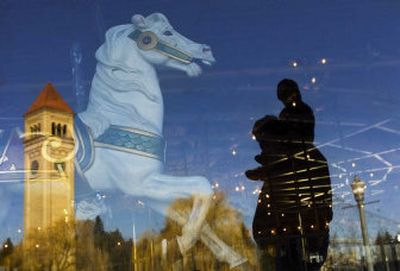Big changes in store for city parks

Installation of a new gondola ride in Riverfront Park last fall was just the start of what could be a series of major changes in Spokane’s century-old park system.
The gondola has drawn nearly 13,000 riders in a little more than three months of limited operation during its fall-winter schedule.
But other major changes are in store for city parks.
The Spokane Park Board is reviewing a draft proposal for a 20-year strategic plan that officials hope will guide park system improvements while at the same time preserving financial stability. Parks officials said they want to hear from the public on the plan over the next several months.
It calls for developing a science center, a series of new swimming pools and an amusement area on the north bank of the Spokane River on property previously used as a dairy.
“We need to change,” said Jeff Halstead, outgoing president of the Park Board, who has shepherded the strategic plan as a way for the park system to grow without relying on non-voted tax subsidies.
“We definitely want the public’s input,” Halstead said.
Copies of the “20/20 Strategic Plan” are available at the Park Department office on the seventh floor of City Hall. The draft will also be posted on the city’s Web site at www.spokanecity.org. The plan is being submitted to the city’s 27 neighborhood councils for comment.
Proposed changes at Riverfront Park include:
Constructing a larger building for Riverfront Park’s historic Looff Carrousel, along with a café, party area, restrooms and ticket window.
Developing city-owned property north of the river and east of the Spokane Arena with new recreation facilities such as a science center, aquatics center, ice skating rink and new IMAX theater. The property was purchased with money from a 1999 voter-approved bond issue.
Renovating the existing Pavilion for more passive uses such as a performance amphitheater.
Straightening the Howard Street corridor to create a grand pedestrian walkway connecting a new north bank amusement area with the rest of the park and downtown shops to the south.
Re-landscaping to open views to the river and give the park a more unified feel. Some of the existing landscape features date back more than 30 years when the former rail yards were transformed into the site of Spokane’s Expo ‘74 world’s fair, the precursor to today’s Riverfront Park.
While the strategic plan talks about major changes in park features, it also proposes ways to put the city’s park system on a stronger financial footing. Many of the proposed park improvements will have to be self-supporting, parks officials said.
The move toward self-sufficiency is driven in part by bad budgets. In 2005, the park department faced nearly $1 million in cuts because tax revenue was not keeping pace with higher costs for salaries and benefits. Tight budgets are expected to continue through the rest of this decade.
The strategic plan calls for capitalizing on potential money-making attractions such as the Carrousel, gondola and a new café in the southwest corner of Riverfront Park. Corporate sponsorships are proposed.
An example of sponsorships might be the new Rotary fountain at the park’s south entrance, which was installed through a fundraising drive of downtown Spokane’s Rotary Club 21. The park department paid for the plaza holding the fountain.
Riverfront Park Manager Craig Butz said the city is working with the fountain contractor to figure out how to solve a problem with slight rust stains on the fountain columns. One idea is to polish the metal to remove the discoloration.
Discussions about improvements at Albi Stadium have included consideration of a partnership with an outside organization.
Restoration of a historic garden in Pioneer Park is being funded through a large donation from an anonymous benefactor. The donation will include an endowment to finance ongoing maintenance.
The $2.5 million gondola is a key example of the financial thinking that now pervades the Park Board. It was built on borrowed money after an analysis showed that the 2,500-foot loop ride could easily draw enough customers to make payments on the construction bonds and yield a small operating profit to the park system.
Despite problems getting the ride opened, ride attendance has met initial expectations, Butz said.
“Overall, we are really pleased with the attendance and where we are heading,” he said of the Sky Ride.
A new system of city pools, including an aquatics center with newer-style play features, would require voter-approved bonds for construction, but its operation would pay for itself through admission fees.
The strategic plan is described as a collaborative venture among the Park Board, parks staff and the public.
The draft submitted to the Park Board on Thursday says, “Through our 20/20 Strategic Plan, we can not only maintain our excellent system of parks and recreation, we can make the positive changes necessary to embrace a vibrant future.”